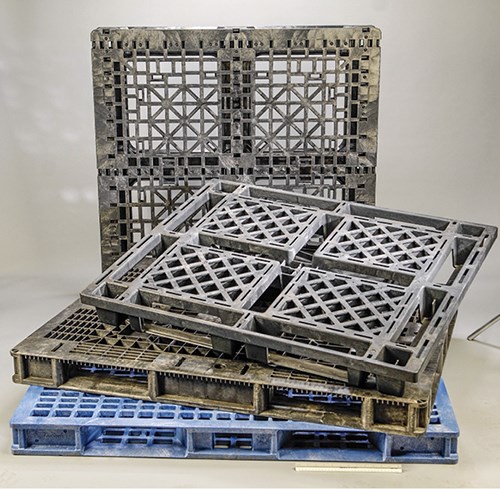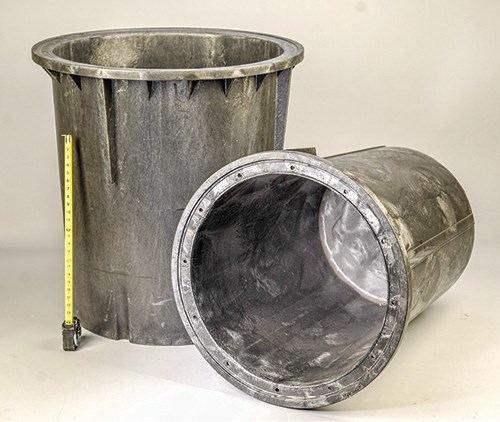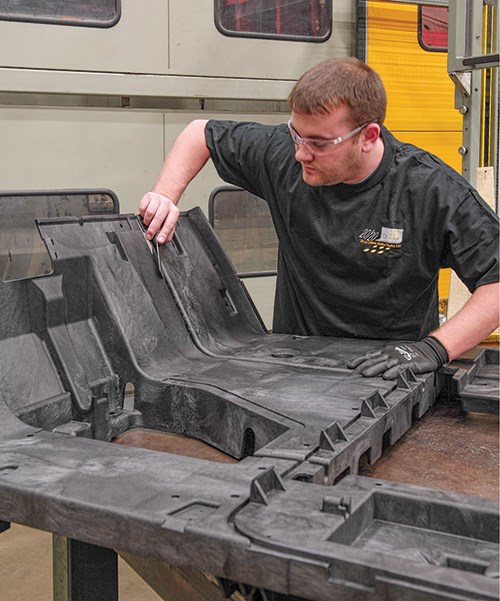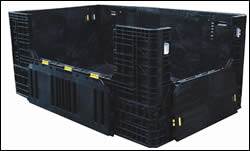Custom Structural Foam: A Small But Thriving Niche
How to succeed in the small but busy world of custom structural foam? Maximize your pounds per hour and use robots.
“About six months after I got into this business, I wondered if I had made a big mistake. But then the light came on, and I got it.” That light has burned brightly for Ron Ernsberger, founder and president of 20/20 Custom Molded Plastics, Ltd. in Holiday City, Ohio. In the 14 years since he started the custom structural-foam molder in 1999, it has grown to a $30+ million-dollar business employing 140.
And business has been good. His plant has expanded several times from an initial 40,000 ft2 to its current 185,000 ft2, and another 165,000-ft2 expansion is underway for warehousing and secondary operations like decorating and assembly. The plant runs 24/7 and, at 85-90% capacity utilization, is pretty much fully booked. “Lots of new things are going on, new molds being built, sample trials running. Our customer base is active and busy,” says Ernsberger. “We have one new customer that will be in our top 10 this year.”
It’s a good time for the structural-foam business generally, says Ed Hunerberg, v.p. of structural foam technologies for Uniloy North America, Tecumseh, Mich., and a widely respected, 42-year veteran in the field. “We have sold more machines in the past year than in any of the previous 10 years, and our customers overall are the busiest they have been in 10 years.” He also notes that the market has been picked clean of available used machines. Reusable material-handling products—pallets and boxes—are responsible for much of the growth, he says.
Ernsberger’s firm serves wide range of markets: lawn and garden products (wheelbarrows, parts for riding mowers), janitorial supplies, shelving, pallets, packaging (bins, boxes, dividers, lids), housings, and cabinetry. He focuses on materials that can run at low torque and high throughput—PE, PP, PS, ABS, and Noryl PPO alloys. He avoids polycarbonate—“It’s a high-torque, low-output material.” Ernsberger started in plastics in 1965 with compression molding, but soon moved into injection molding. Starting in 1977, he worked for two structural-foam molders. “I got into this field by accident, but it turned out to be the right choice.” He started his first firm to do structural foam, Vision Molded Plastics, in Napoleon, Ohio, but sold it four years later. When he started 20/20 he chose a name that continued the “vision” theme.
“When I started in structural foam, it was a novelty. The industry went after the wrong applications—medical enclosures and computer cabinetry—high-tolerance, high-finish parts. The machines of those days (the 1970s) weren’t suitable for those parts, so structural foam got a bad name.” That, and the radical downsizing of computers with the arrival of PCs, put a crimp in the structural-foam business. “It lagged until the end of the ’80s and start of the ’90s, when just-in-time packaging—returnable containers—came in. Since then, structural foam has been growing stronger in new applications and poundage consumed.”
Structural foam is a niche, and will remain so—Ernsberger and Uniloy’s Hunerberg agree on that. Although it competes with solid injection molding for larger, heavier parts, structural foam enjoys several advantages. “I can do on a 500-ton press what an injection molder needs 2500 tons to do,” says Ernsberger. “You can’t mold four pallets at once by injection molding”—not without a mammoth machine. He routinely runs parts weighing 9 to 15 lb, and one job is 168 lb. His largest press has 200-lb shot capacity and platens 162 in. wide x 107 in. high. One job involves molding 16 eight-ft-long parts in a single mold.
“People who come into this from injection molding are overwhelmed by the number of pounds these machines can put out,” he adds. His 1500-tonner has dual 6-in., 600-hp extruders, each of which can plasticate 2400 lb/hr. “Full out, our plant will use 15,000 lb/hr with just nine machines.” He commonly runs two different materials in the two extruders of the same press—such as PP and PE or PS and ABS.
Structural foam also benefits from unusual flexibility. Today’s multi-nozzle presses allow for up to 200 different injection points on the platen, using shutoff nozzles with independent opening and closing control. “It’s a bit like a hot-runner valve-gate system with the hot runner as part of the machine, not the mold,” explains Hunerberg. This system allows multiple injection points on one big mold, or several individual molds to be mounted on one machine. For example, one job has seven molds in one twin-barrel machine, running parts for two different customers in two different materials simultaneously.
Another advantage of low-pressure structural foam is its ability to use aluminum molds at one-third the cost of an injection mold and with shorter lead time. Structural foam also competes in some cases with thermoforming, which enjoys even lower tool cost.
Ernsberger and Hunerberg also agree that, in some respects, structural foam is easier to run than solid injection molding. “It’s a very forgiving process,” says Ernsberger. “You run a black foam fan shroud and it’s a lot less trouble than a crystal-clear polycarbonate part.” He notes that “the old structural-foam swirl” is not so evident on today’s parts, but adds that “we don’t do high-finish applications.” He leaves that to other foam molders that specialize in techniques like gas counterpressure.
The 20/20 plant today has five Uniloy dedicated structural-foam presses of 500, 1000, and 1500 tons, plus four Milacron injection machines of 375 and 725 tons. The latter have oversized barrels (165 and 288 oz, respectively) so they can be used for foam or for solid injection molding of handles, fasteners, and other attachments to be assembled with foam parts.
All of 20/20’s presses are also equipped for gas-assist molding, and the firm sometimes uses that technique together with structural foam to save weight and material. In addition, Ernsberger’s Uniloy foam presses have software for structural web molding, a type of low-pressure gas-assist process that hollows out most of an unfoamed part and leaves a smooth surface.
“The machines are much better now,” Ernsberger notes. “They may look the same as they did 30 years ago, but the hydraulics, electrics, and controls are so much improved. The same part I ran in the late ’80s at 160 sec, ran in the ’90s at 145 sec and runs now at 75 sec.”
ROBOTS: THE NEW NECESSITY
Some of that improved productivity is due to the arrival of robots, says Ernsberger. Starting in 2003, 20/20 was an early adopter of robots for structural foam. “Before then, I never thought robots would be a help rather than a hindrance—something that would slow you down on mold changes and setups. I didn’t want to mess with them. But then Ranger Automation Systems (Shrewsbury, Mass.) came in with the biggest robot they had ever built and asked us to try it out for free. Now we have Ranger robots on all our machines, and the two biggest (1000 and 1500 tons) have two robots on the same beam to handle multiple molds.” The robots can carry 280 lb.
“The big thing with robots is cycle-time uniformity. It eliminates the variability of a human operator. Your scrap rate goes down and productivity goes up. Adding those nine robots was like adding another machine in terms of overall productivity.”
Even with those top-entry beam robots, some jobs have up to five people working at a machine for secondary operations like trimming, assembly, and hot stamping. And 20/20 does not yet use the robots for loading inserts but probably will in the future, Ernsberger says.
Hunerberg says 20/20 is the first structural-foam molder he knows of that put robots on all its machines. He says robots have caught on with captive structural-foam molders but estimates that robots are used by only half of custom foam molders, which have shorter runs and frequent mold changes.
That has not been a deterrent to 20/20, says Ernsberger. “For us, a long run is two or three days. We make three mold changes a day.” He says that takes from 4 hr for small parts to two days for the largest (168-lb) job. “We have it down to a science.” One key is that 20/20 has standardized its mold shut heights to simplify changeovers.
THINNER CUSTOM RANKS
From around a dozen custom structural-foam molders in the U.S. when 20/20 started up, the custom ranks have shrunk to single digits, Ernsberger says. Some were acquired by captive molders, which constitute a majority of the foam business, according to Hunerberg.
Ernsberger cites two keys to 20/20’s success. “The first is our knowledgeable, experienced people.” Most are long-timers with the company. It’s very hard to find people with any foam experience, he says. “It’s hard to find people who can pronounce ‘polyethylene,’ let alone ones who know how to mold structural foam.”
In fact, 20/20 has cooperated with Uniloy to train several companies—three domestic and two foreign—in the ways of structural foam. “When I got into this industry, everyone kept to themselves, didn’t want to help other molders, didn’t want to share knowledge. They were so afraid someone would steal something from them. I’ve tried to change this culture, because if a new guy gets into structural foam and doesn’t know what he’s doing, he could give all of us a black eye.”
Ernsberger doesn’t mind that the technology has spread to at least seven other countries, including China, Taiwan, Latin America, Russia, and the Middle East. He doesn’t worry about overseas competition because structural-foam parts tend to be too large and heavy to be shipped economically over long distances.
The other key factor in 20/20’s success, Ernsberger says, is his equipment. “When I started there was no good used machinery available. I was lucky. I had to buy new machines, so I got the latest technology and my maintenance cost was zero.” Now his machines are turning 10 years old. “We take good care of them.”
What he wants from the machinery suppliers today is higher output. “What any foam molder wants is more lb/hr. We started with 115-hp extruders; in ’93 we went to 400 hp and I thought that’s all I would ever need. We have 600 hp today and that’s not enough.
“We have some ideas of our own on how to customize new machines. We want to increase our plant’s lb/hr throughput by 20% with the same number of presses.”
Hunerberg says 600 hp is pretty much the limit for a 6-in. extruder. But Uniloy has built 8-in. extruders with 1000 hp, “monsters” capable of 5500 lb/hr apiece, more than twice the output of dual 6-inchers. Another improvement would be a screw design optimized for a specific material, though that may not be a convenient solution for a custom molder.
Ernsberger also says he is concerned about energy costs. “My 500-tonner consumes more energy than a 1500- or even 2500-ton injection press because of all the heating on the extruders, accumulators, fill pipes, and manifolds.” Hunerberg replies that Uniloy machines already use electric variable-speed screw drives, hydraulic accumulators, and variable-volume pumps to minimize energy consumption. But he foresees that in the next two years Uniloy’s next generation of machines will adapt electric servo-driven pumps to save additional energy, as is already the case for injection machines.
In addition, new technology was recently announced by Norsdson Xaloy (New Castle, Pa.) for more energy-efficient heating of injection barrels, nozzles, and melt pipes (see Keeping Up section).
Apart from technical needs, what Ernsberger wishes for most is more cohesiveness within the structural-foam industry. He recalls how 20 or more years ago, structural foam had a prominent presence in industry conferences. “We need to promote structural foam from within,” he says. Ernsberger himself tried to organize a structural-foam pavilion at NPE 2012 in Orlando, Fla., but that did not bear fruit. If any movement were made in the future to organize this industry sector, he says, “I would want to be a part of that.”
Related Content
Haitian Develops Special Edition JU, MA Series for Increased Energy Savings
These models are designed to enable molders to select the right performance level for their needs with the same energy savings but at a lower cost.
Read MoreAbsolute Haitian Brings Next Generation of Presses to Orlando
NPE2024: Absolute Haitian says Generation 5 of the servo-hydraulic Haitian and electric Zhafir machines lines emphasize efficiency, performance and intelligence.
Read MoreLS Mtron’s Outsized NPE2024 Presence Jump-Starts Ambitious North American Market Goals
The Korean maker of injection molding machines featured eight machines in its nearly 14,000-square-foot booth with additional presses at Yushin and Incoe’s booths, as it targets 20% market share.
Read MoreNetstal To Introduce Next-Generation All-Electric Elion Injection Molding Machines at K 2025
Netstal will introduce the Elion MED in Düsseldorf with a smaller footprint and greater energy efficiency.
Read MoreRead Next
Structural Foam: As Parts Grow Larger, Robots Do the Heavy Lifting
Besides its safety advantages, automation stabilizers and even reduces cycle times, boosting production and cutting scrap.
Read MorePeople 4.0 – How to Get Buy-In from Your Staff for Industry 4.0 Systems
Implementing a production monitoring system as the foundation of a ‘smart factory’ is about integrating people with new technology as much as it is about integrating machines and computers. Here are tips from a company that has gone through the process.
Read MoreBeyond Prototypes: 8 Ways the Plastics Industry Is Using 3D Printing
Plastics processors are finding applications for 3D printing around the plant and across the supply chain. Here are 8 examples to look for at NPE2024.
Read More



























